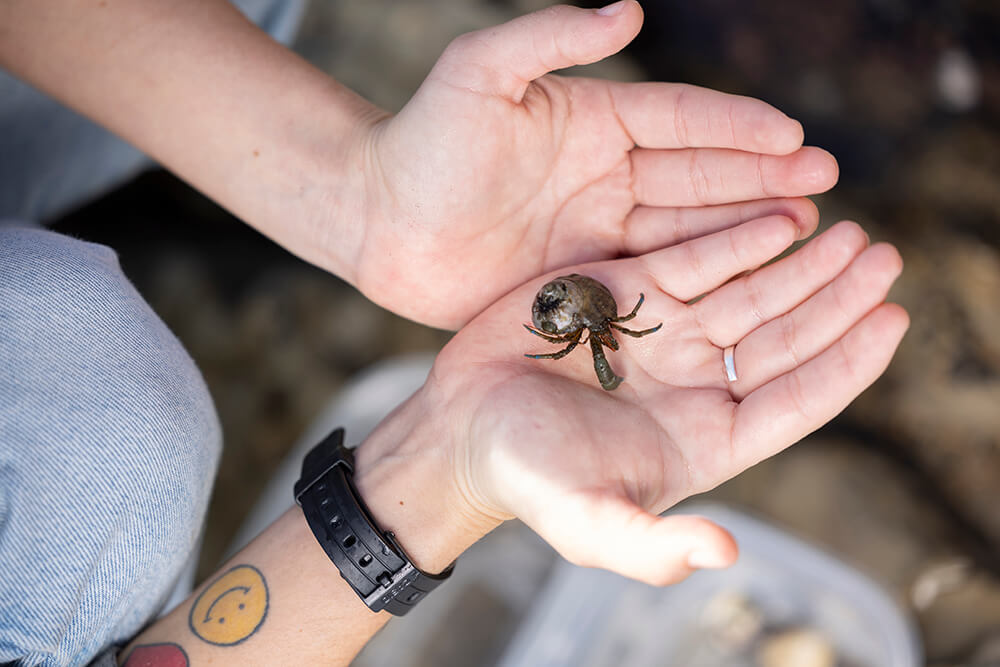
Steps from the ocean on the rocky shores near San Pedro, graduating student researcher Tabitha Martinez scours the tide pools in search of tiny blueband hermit crabs.
Martinez aspires to become an animal biologist and pursue a career as a university professor and field-based researcher.
With distinctive blue bands on their legs, these hermit crabs are common inhabitants of black turban snail shells. The crabs live in Southern California’s intertidal zones and play an important ecological role in marine life.

Martinez, a Cal State Fullerton Class of 2025 grad and double major in biological science and anthropology, is assessing how human handling impacts the hermit crabs’ physiology and behavior.
“Blueband hermit crabs are extremely popular and easily accessible at our Southern California beaches,” Martinez said. “Other intertidal creatures, like anemones, have been studied in response to human interaction and disturbance, but hermit crabs have not. I want to see if excessive handling stresses them out.”
In the fall, she will start UC Riverside’s doctoral program in evolution, ecology and organismal biology. Martinez will join the Animal Aeroacoustics lab, which studies the sounds animals make when they fly.
Martinez’s science-related activities with MARINe (Multi-Agency Rocky Intertidal Network) and research adviser Jennifer Burnaford, professor of biological science, inspired her project. Burnaford’s Intertidal Community Ecology Lab students work with MARINe to monitor and study biodiversity trends in Southern California intertidal zones.
Through this work, Martinez noticed how easily the hermit crabs are prone to be handled by tourists and questioned whether human disturbances negatively affect them.
“Tabitha’s combination of enthusiasm, hard work and attention to detail has led to this highly interesting study,” Burnaford said. “Her data will help scientists and coastal managers better understand how interactions with humans affect the animals on rocky intertidal shores.”
Under the guidance of Burnaford, Martinez’s project focuses on measuring how human handling affects the crustaceans by calculating their metabolic rate to determine stress levels.
“Given their importance to the ecosystem, it’s crucial to address potential anthropogenic threats — environmental changes caused by people — they are facing,” she said. “They’re easy targets for people to grab and disturb.”

Martinez said her study will provide insights into how the nocturnal foragers react to human disturbance, contributing to further understanding anthropogenic stressors in the intertidal zone.
“Hermit crabs are important to the ecology of intertidal zones because they help consume decaying matter and are prey to other intertidal species,” Martinez explained.
She plans to finalize the results of her study, supported by student research funds from the California State University Council on Ocean Affairs, Science & Technology and Department of Biological Science, before she graduates in May.
Martinez participated in other undergraduate research experiences, including an 11-week internship through COAST at the Cabrillo Marine Aquarium in San Pedro.
As a COAST intern last summer, Martinez developed an enrichment program for the Kellet’s whelk, a large and carnivorous sea snail that lives in the intertidal zone.
“This opportunity gave me a glimpse into what research entails, including a lot of trial and error,” she said.
Martinez shared that her research and science-related activities, which include the Louis Stokes Alliance for Minority Participation program, an officer of CSUF’s Society for the Advancement of Chicanos/Hispanics in Science chapter and a conservation intern at the nonprofit OC Habitats, have prepared her for graduate school success.
“Dr. Burnaford and other faculty members have been supportive and pointed me toward enriching opportunities,” she said. “My time here at CSUF has been an invaluable experience in terms of my academic and personal growth. Now, I am a proud Latina scientist.”